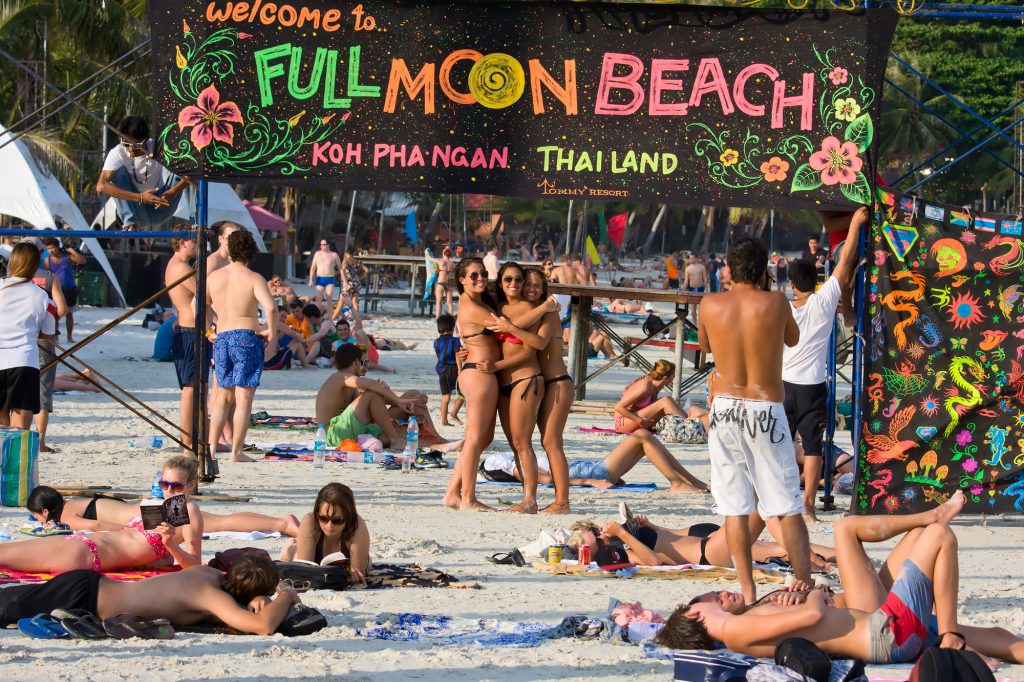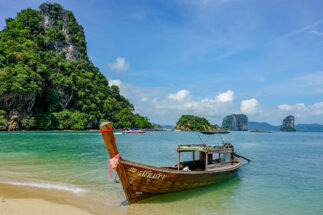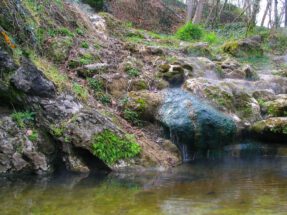
Best Festivals in Thailand
When it comes to festivals, Thailand knows how to throw a party! From the famous Full Moon Parties on Koh Phangan to the Chiang Mai Flower Festival, there’s always something happening in this vibrant country. But, one festival that truly stands out is the Songkran Festival, also known as the Thai New Year’s Festival.
Imagine water fights, street parties, and parades all in the name of celebrating the new year. That’s exactly what you’ll find at the Songkran Festival. Held annually in April, this festival is all about cleansing and renewal. People take part in religious ceremonies, visit temples, and pour water over statues of Buddha as a symbol of purification. But, the real fun begins when the streets fill with locals and tourists alike, armed with water guns and buckets, ready to douse anyone in sight!
The Songkran Festival is a true celebration of Thai culture and tradition. It’s a time for families to come together, for forgiveness and for forgetting past mistakes. The streets are filled with laughter and joy as people dance, sing, and play together. If you’re looking for a unique and exciting festival experience, then the Songkran Festival is a must-see. So, pack your water gun and get ready to make a splash at the Thai New Year’s Festival!
Songkran Festival (Water Festival)

Are you ready for one of the wildest and most beloved festivals in all of Thailand? Look no further than Songkran, the traditional Thai New Year celebration! This festival embraces goodwill, love, compassion, and thankfulness, and uses water as the means of expression.
The word ‘Songkran’ derives from Sanskrit, meaning ‘to move or step forward.’ This is fitting, as the festival marks the start of a new year, when the sun moves from Pisces into Aries, according to the Brahmin solar system. The festival takes place annually on April 13th, 14th, and 15th, with the first day known as ‘Maha Songkran’ or ‘the grand Songkran.’
The Thai government has declared Songkran festival as extended public holidays to enable people to return to their hometowns for family reunions, merit-making, and reuniting with others in their community. April 13th is also declared the Day of the Senior or Elderly by the government, a day to appreciate the senior population for their years of contribution to the family and country. April 14th is designated as Family Day, a day to celebrate family love and togetherness.
During Songkran, the streets are filled with people armed with water guns, hoses, and buckets, ready to douse anyone and everyone in sight. It’s a non-stop water fight and an unforgettable experience. Expect to get wet, and bring a waterproof bag to keep your belongings safe.
But Songkran isn’t just about water fights, it’s also a time for traditional Thai New Year’s customs such as paying respects to elders by pouring scented water over their hands and offering them a white thread tied with a coin, as well as visiting temples to make merit and make offerings to the monks.
Loi Krathong Festival

Loy Krathong, the festival of lights! This annual celebration sees people taking to the waters to release small, illuminated boat offerings made of banana stalks and leaves. The sight of thousands of lights floating across the country’s rivers and canals is a point of intrigue for visitors from all over the world.
But where did this festival come from? What exactly is a krathong? And why is water so central to this celebration?
Loy Krathong is a festival celebrated by the Thai people on the full moon night of the twelfth month of the Thai lunar calendar. This event usually occurs in the month of November, though the date varies from year to year. Regardless of the exact timing, Loy Krathong is always considered as an occasion for joy, gratitude, and new beginnings.
The term “Loy Krathong” is derived from the word “loy” – meaning “to float” – and the word “krathong” – which refers to a type of small, floating religious offering. The highlight of the festival is the floating of krathongs across small and large bodies of water all over the country. The objective for this act varies depending on customs and beliefs, but generally include the worship of Phra Mae Khongkha, the goddess of water, Lord Buddha, Venerable Upagupta, Lord Vishnu, and ancestors.
In addition to the floating of krathongs, other Loy Krathong activities include the floating of sky lanterns, Buddhist religious ceremonies, and traditional dances and performances.
So, grab your own krathong and join in on the fun! The Loy Krathong festival is a truly magical experience that you won’t want to miss. With its vibrant energy, cultural customs, and mesmerizing display of lights, Loy Krathong is a one-of-a-kind celebration that will leave you in awe.
Yi Peng Lantern Festival

Yi Peng Lantern Festival, a unique celebration found only in northern Thailand, closely linked with the ancient Lanna kingdom. This festival, adapted from Brahmin origins, marks the end of the rainy season and the start of winter. It takes place at the same time as Loy Krathong and Chiang Mai has become the city most synonymous with Yi Peng.
As you wander around Chiang Mai during Yi Peng and Loy Krathong, you will see lanterns and special parades everywhere. Colorful lantern displays are set up at the Three Kings Monument, Thapae Gate and at all other gates around the moat that encircles the Old Town district of Chiang Mai. Temples and households decorate their front entrances with coconut leaves and flowers. On Yi Peng Day (the night of the full moon for Loy Krathong), lanterns or candles are also lit and placed at entrances to shops, homes and temples. The act of making the lanterns or donating them to temples is one way of making merit and the light of a lantern is significant in Buddhist culture because it represents the moving away from darkness into a brighter future.
There are four main styles of lanterns: khom kwaen (hanging lantern), khom thuea (carrying lantern) also known sometimes as khom gratai (because it resembles a rabbit’s ear), khom paad (revolving lantern) and khom loy (hot air floating lantern also known as khom fai). The release of lanterns (khom) is a way to pay respect to Buddha and also to release bad memories and make a wish for the future. During Yi Peng, it was traditionally monks who released the lanterns, but now anyone can do so. On Yi Peng Day (Loy Krathong Day), novice monks at some of the temples will release giant sky lanterns in the morning. These will normally have firecrackers attached to them and if you are staying in Chiang Mai, you will be sure to hear these khom fai even if you don’t see them.
In the evening, khom loy (floating lanterns) are released all around Chiang Mai province. In the city, the main areas are around the Ping River and at various locations around the moat. Many temples, including Wat Phan Tao and Wat Chedi Luang, are a wonderful place to enjoy the festivities away from some of the more crowded areas near the river. People release the lanterns from dusk until the early hours of the morning and it is a wonderful sight set against the backdrop of the full moon.
The Yi Peng Lantern Festival is an experience like no other, with its vibrant energy, cultural customs, and mesmerizing display of lights.It’s a must-see event for anyone visiting northern Thailand during the festival. It’s a time to let go of negative thoughts and make wishes for the future, while also paying respect to Buddha and the Thai ancestors. The release of the lanterns is a truly magical experience that will leave you in awe and create memories that will last a lifetime.
Beyond the floating of lanterns, Yi Peng also offers a variety of other activities, such as traditional dances and performances, local food vendors and traditional Thai games. It’s a great opportunity to immerse yourself in the local culture and make lasting connections with the people of Chiang Mai.
Phuket Vegetarian Festival

The Phuket Vegetarian Festival! This annual event, held on the 9th lunar month of the Chinese calendar, usually in September or October, celebrates the Chinese community’s belief in the power of abstinence from meat and various stimulants to bring good health and peace of mind.
But let’s be real, the real attraction of this festival is the ‘extreme’ celebrations. The festival is famous for its self-mortification rituals, where participants act as mediums of the gods and undertake acts such as firewalking and body piercing. These rituals have become increasingly spectacular and daring each year.
The festival has a rich history that dates back to the 19th century when it is believed that a wandering Chinese opera group fell ill from a malaria epidemic. One of the performers was sent to China to invite the Nine Emperor Gods (known as the Kiu Ong Iah) to Phuket. The Chinese followed the tradition of refraining from eating meat, drinking alcoholic drinks, engaging in sex, quarreling, telling lies, or killing. This was to ensure the purification of the mind and body. The opera group made a complete recovery and the epidemic ceased. Since then, the people of Phuket have continued to celebrate the festival.
Lopburi Monkey Banquet

The Lopburi Monkey Banquet! This annual event is all about treating the macaques in the city to a lavish feast as an expression of gratitude towards the primates.
Located about 150km north of Bangkok, the ancient city of Lopburi is home to thousands of monkeys that coexist with the locals – and they’re not just any ordinary monkeys. According to the Thai version of the Indian’s Ramayana, the national epic of Ramakien, the monkeys in Lopburi are the direct descendants of Hanuman, god-king of the apes.
The Lopburi Monkey Banquet is one of the biggest and strangest festivals in Thailand and it usually takes place on the last Sunday of September. The festival will be held at Phra Prang Sam Yot temple and it kicks off in the morning with an opening ceremony, dances, and musical performances. Eventually, the monkeys, usually first overwhelmed by the large number of spectators, are treated to a buffet of sticky rice, fruits, vegetables, salads, and drinks. These banquets are sometimes spread out into separate times during the day.
Like any other event in Thailand, food plays a pivotal role, and it’s not just for the monkeys. Visitors can also enjoy a wide range of local Thai delicacies from the food stalls. Once the monkeys have satiated their appetites and gotten used to the cheering crowd, they can get very boisterous and create quite a ruckus. Visitors are advised to watch out for these petulant macaques, as they can cause quite a stir when they start mischievously latching on to your belongings.
Ubon Ratchathani Candle Festival

The Ubon Ratchathani Candle Festival! This traditional festival takes place during Asahna Bucha and Khao Phansa days, two important Buddhist events that celebrate Buddha’s first sermon and the beginning of Buddhist Lent. It’s a religious event but don’t let that fool you – there’s plenty of sanuk (fun) to be had.
As you wander through the streets of Ubon Ratchathani, you’ll be mesmerized by the large-scale, colorful parades of magnificent floats with huge, extravagant candlewax sculptures, Thai traditional dance and music. The artisans, both monks and laymen, use candles as the basic material to create incredible waxwork structures depicting scenes and figures from Buddhist mythology. It’s a true window into authentic Thai culture.
But the highlight of the festival has got to be the candle float parade on the morning of Khao Phansa day. The streets are packed with spectators and the atmosphere is electric. The elaborately decorated floats are incredibly colorful, with contests and prizes for the most impressive ones and the most beautiful candle sculptures. And don’t forget about the international sculpting competition, where teams make large wax candle sculptures that can reach up to 20 meters in height, decorated with Thai patterns and scenes from the Ramayana and other epics.
Surin Elephant Festival

The Surin Elephant Festival! This annual event, taking place on the 3rd weekend of November, is a celebration of the mighty elephant and their role in Thai culture.
With over 300 elephants in attendance, the festival is a visual feast for all ages. From elephant soccer games to dragging contests, there’s something for everyone to enjoy. But the highlight of the festival for the elephants themselves? The massive buffet of their favorite fruits and vegetables is beautifully arranged on nearly 100 tables. Not only do you get to witness the daily life of these gentle giants, but you also get to see the message of peaceful coexistence between humans and wildlife in action.
But the fun doesn’t stop there! On Saturday, the elephants and their mahouts head to the city’s football stadium for a mock battle reenactment, showcasing the historical role of elephants as war machines in Southeast Asia. And let’s not forget the traditional Thai dance and music performances, as well as the participation of local school and community groups in traditional costumes.
The Surin Elephant Festival is a unique opportunity to see elephants up close and personal, and it’s also a chance to learn about and appreciate Thai culture and history. And don’t forget, there’s plenty more to explore in Surin and the surrounding area – temples, fairs, Thai handicraft villages, ancient ruins, and Khmer temples.
Wing Kwai (Buffalo Racing Festival)

The Wing Kwai (Buffalo Racing Festival)! This iconic event takes place in the beautiful city of Chonburi, just 80 km southeast of Bangkok, and brings together locals, tourists, and of course, buffaloes for an unforgettable celebration.
The festival is all about buffaloes – the symbol of Thailand’s agriculture and rural life. The festival begins at the Wat Yai Intharam temple, where Buddhist monks perform a religious ceremony called ‘Tedmahachart.’ Here, farmers offer rice, coconut, betel nut, sugarcane, and banana to the monks and seek blessings for their families and buffaloes.
The parade to the temple is a sight to behold, with hundreds of people and 13 buffaloes marching through the streets. After the ceremony, the buffaloes are prepared for the main event – the races. The farmers challenge each other, and even brave tourists can participate in small-scale competitions. The traditional rule is that the jockey must finish the race sitting on the back of the buffalo – if they fall off, they’re disqualified. The spectators enjoy the sight of the jockeys trying to hold on while the buffaloes race to the finish line.
After the award ceremony, the champion buffalo and its owner parade around the city, showing off their victory to the people of Chonburi. This unique event is a boost to the local economy and provides entertainment for all. As BBC and CNN have covered, the Wing Kwai Buffalo Racing Festival is a must-see event for anyone visiting Thailand.
Rocket Festival Thailand (Bun Bang Fai)

The Bun Bang Fai Rocket Festival in Yasothon! This annual festival, held on the second weekend of May, is a must-see event for anyone visiting Thailand. Imagine hundreds of huge rockets being launched into the sky, all in the name of bringing on the rainy season. These rockets can weigh over 100 kg and fly for over five minutes!
But it’s not just about the rockets, there’s a whole weekend of fun to be had. The festival kicks off on Friday with a cultural performance at Phaya Thaen Public Park, where you can check out the beautifully decorated rockets on display. Then, head to the main road for a massive party with stages blasting different music styles, from traditional Issan music to techno and rock.
Saturday is all about the parade, where groups perform choreographed dances for judges. And on Sunday, it’s time for the main event – the rocket launches! Head to the launch site, not far from Phaya Thaen Public Park, to see dozens of rockets soar into the sky. And if you’re feeling brave, you can even get up close to see the teams assemble and prepare their rockets.
But the fun doesn’t stop there, the festival also includes food stalls, a market, and even a snake show. And if any rocket fails to launch, the team is thrown into a mud pit for some good old-fashioned public humiliation. So pack your earplugs, bring a hat or umbrella, and get ready for an unforgettable experience at the Bun Bang Fai Rocket Festival in Yasothon. Trust us, it’s a once-in-a-lifetime experience you won’t want to miss!
Phi Ta Khon (The Happy Ghost Parade)

Get ready for a spooky-good time at the Phi Ta Khon festival, also known as the Happy Ghost Parade! This annual event, held in Northeastern Thailand’s Dan Sai District during the rainy season, is a celebration of the Boon Luang Festival, and it’s an experience you won’t want to miss.
What is Phi Ta Khon? It’s a tradition where locals and visitors alike dress up in masks and costumes made of discarded cloth and take to the streets to show off their funny dance moves and entertain the crowd. This festival is a great opportunity to make merit and worship the city’s guardian angels and holy spirits. But where did it all start? The origins of Phi Ta Khon are shrouded in mystery, but there are a few legends that attempt to explain it.
One theory is that it comes from the Buddhist Jataka story of Prince Vessantara, where ghosts and animals disguise themselves as humans to bid farewell to the prince and his wife. Another theory is that it’s a way to pay homage to the spirits of deceased ancestors. And a third legend tells of a giant tree that blocked the sunlight and caused poverty, until an elderly couple volunteered to cut it down, with the request to be remembered when they passed away.
So, how is Phi Ta Khon celebrated? The festival lasts for three days, with the main event being the summoning of Phra Upakhut on the first day. The second day is when the parade takes place, with people dressed as Phi Ta Khon dancing and entertaining the crowd. And on the third day, there’s a traditional rocket festival and a ceremony to ward off bad luck for the country. It’s a unique and exciting festival that combines tradition, culture, and entertainment, and one that’s definitely worth experiencing. Join in the fun and see for yourself at this year’s Phi Ta Khon festival!
Traditional Ascent Of Phanom Rung Hill

Are you ready for a truly unique and unforgettable experience? Look no further than the Traditional Ascent of Phanom Rung Hill Festival! Every year, at this time, thousands of people gather on the western side of Phanom Rung to witness the sun rising through the fifteen perfectly aligned doors of the temple. It’s a moment that will take your breath away and leave you in awe.
The festival begins with a ritual to wish for the success of the event, followed by a traditional royal Khmer parade that will transport you back in time. The parade features ornately decorated elephants and traditional dancers dressed in vibrant costumes, making it a feast for the eyes.
As the day turns into night, the temple comes alive with a mini sound and light show that brings the historic remains of Phanom Rung to life. The temple is bathed in an array of colors, and the sound of traditional music fills the air. It’s a truly magical experience that you won’t want to miss.
Phanom Rung Hill is a UNESCO World Heritage Site and one of the most important Khmer temples in Thailand. It’s a must-visit destination for anyone interested in history and culture. The Traditional Ascent of Phanom Rung Hill Festival is the perfect opportunity to explore this ancient site and immerse yourself in the local
Chinese New Year in Bangkok

One of the most vibrant celebrations in Bangkok as Chinese New Year takes over Yaowarat, the city’s Chinatown. The streets come alive with the sound of exploding firecrackers, dragon dancers, and throngs of people paying their respects. This is the time of year when Chinese families gather to enjoy the festivities and indulge in delicious banquets.
But it’s not just Yaowarat that celebrates Chinese New Year. Restaurants and malls throughout Bangkok also get in on the action, with special sales and cultural performances. Whether you’re Chinese or not, it’s impossible not to get caught up in the excitement of this annual event, which usually takes place in January or February, depending on the Chinese Lunar Calendar.
One of the highlights of the celebration is the dragon parade, where you’ll see majestic dragons dancing through the streets, led by a team of skilled dancers. You can also try your hand at Siem see, a traditional Chinese fortune-telling practice, and visit Wat Mangkon Kamalawat, a temple that’s packed with locals praying to deities. So, put on your red clothes, and get ready to experience Chinese New Year like never before.
Full Moon Parties in Koh Phangan

The Full Moon Parties on Koh Phangan! But who invented these legendary parties? While the origins are shrouded in mystery, it’s said that a group of tourists in the 80s stumbled upon the remote island and discovered the stunning Haad Rin beach, perfect for a full moon celebration. Fast forward to today and the party attracts 20,000-30,000 people each month, ready to dance the night away under the light of the full moon.
What makes the Full Moon Parties on Koh Phangan so special? For starters, the natural setting of the island and Haad Rin beach create a magical atmosphere. Plus, the international crowd means you’ll be partying with people from all over the world. And let’s not forget the sense of freedom and joy that permeates the party.
But what can you expect at the party? A diverse crowd of people, delicious food and drinks on every corner (including the famous bucket drinks), and a ticket price of only 200 Baht (around 6 USD). Just make sure to watch out for your feet as the beach can get a bit trashy. So pack your bags and get ready for the ultimate party experience at the Full Moon Parties on Koh Phangan!
Charming Chiang Mai Flower Festival

The Charming Chiang Mai Flower Festival is not just about admiring the beautiful blooms, but it’s also a celebration of art, light, and color. The festival is a perfect opportunity to get in touch with nature and appreciate the beauty of the environment. The festival is also a great way to learn more about the different types of flowers and plants that are native to the area.
One of the highlights of the festival is the Zone 1 Tropical Rain Forest. This zone is filled with various species of orchids, such as Phalaenopsis and Vanda, as well as other ornamental flowers. The Zone 2 Winter Flowers Garden is another must-see, as it showcases colorful winter flowers, such as tulips, hydrangeas, lilies, cyclamen, and lisianthus.
Zone 3 The Power of Sunshine is a celebration of the power of the sun and the beauty of tropical flowers. This zone features hollyhocks, geraniums, double-flowered begonias, and colored pineapples. The Zone 4 Season Change is a corner that allows visitors to capture beautiful pictures and experience the colorful atmosphere of all four seasons.
The Zone 5 Field of Violets is a highlight of the festival, showcasing a Blue Sunvia flower field in full bloom. The highlight of this zone is the musical fountain show, which takes place three times a day at 7:00 p.m., 7:45 p.m., and 8:30 p.m.
BearTravelGuide is a travel blogger sharing adventures and insights from remote destinations around the world. He has a passion for adventure and a thirst for new experiences, which he shares on his successful blog. Join BearTravelGuide to discover the world one adventure at a time.











